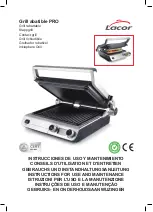
• Injuries caused by touching any rotating/
moving parts.
• Injuries caused when changing any parts,
blades or ac cessories.
• Injuries caused by prolonged use of a
tool. When using any tool for prolonged
periods ensure you take regular breaks.
• Impairment of hearing.
• Health hazards caused by breathing dust
developed when using your tool
(example:- working with wood, especially
oak, beech and MDF.)
Vibration
The declared vibration emission values
stated in the technical data and the
declaration of conformity have been
measured in accordance with a standard
test method provided by EN 60745 and may
be used for comparing one tool with
another. The declared vibration emission
value may also be used in a preliminary
assessment of exposure.
Warning!
The vibration emission value
during actual use of the power tool can
differ from the declared value depending on
the ways in which the tool is used. The
vibration level may increase above the level
stated.
When assessing vibration exposure to
determine safety measures required by
2002/44/EC to protect persons regularly
using power tools in employment, an
estimation of vibration exposure should
consider, the actual conditions of use and
the way the tool is used, including taking
account of all parts of the operating cycle
such as the times when the tool is switched
off and when it is running idle in addition to
the trigger time.
Extension Cord Safety
Warning!
Keep the extension cord clear of
the working area. Position the cord so it will
not get caught on the workpiece, tools or
any other obstructions while you are
working with the power tool.
Make sure any extension cord used with this
tool is in good condition. When using an
extension cord, be sure to use one of heavy
enough gauge to carry the current the tool
will draw. An undersized cord will cause a
drop in line voltage resulting in loss of power
and overheating.
Be sure your extension cord is properly
wired and in good condition. Always replace
a damaged extension cord or have it
repaired by a qualifi ed electrician before
using it. Protect your extension cord from
sharp objects, excessive heat and damp or
wet areas.
Use a separate electrical circuit for your
power tools. This circuit must not be less
than 14 gauge wire and should be protected
with either a 15 A time delayed fuse or circuit
breaker. Before connecting the power tool to
the power source, make sure the switch is in
the OFF position and the power source is
the same as indicated on the nameplate.
Running at lower voltage will damage the
motor.
Contents
Carefully unpack the drywall screwdriver.
Compare the contents against the “Drywall
screwdriver components” chart below.
Assembly and Operating
Warning!
To avoid fi re or toxic reaction,
never use gasoline, naphtha, acetone,
lacquer thinner or similar highly volatile
solvents to clean the tool.
Forward/Reverse switch (Fig. B)
The forward/reverse switch (4) is
conveniently mounted in front of the
variable speed trigger switch (5). To make
the screwdriver rotate clockwise for driving
screws, push the forward/ reverse switch (4)
to the left. To make the screwdriver rotate
counter-clockwise to remove screws, push
the forward/reverse switch (4) to the right.
Notes:
a. Never change the position of the
forward/ reverse switch (4) while the
screwdriver bit is turning.
b. The variable speed trigger switch (5) will
NOT function with the forward/reverse
switch (4) in the middle position.
7
ENGLISH
(Original instructions)
Summary of Contents for BDSG500 Linea PRO
Page 1: ...BDSG500 www blackanddecker com EN FR PT RU TR UA AR ...
Page 2: ...ENGLISH 2 Original instructions 3 1 2 4 4 5 5 5 6 FIG A FIG B FIG C ...
Page 68: ......
Page 73: ......
Page 74: ......
Page 75: ......
Page 80: ...12 2015 ...








































